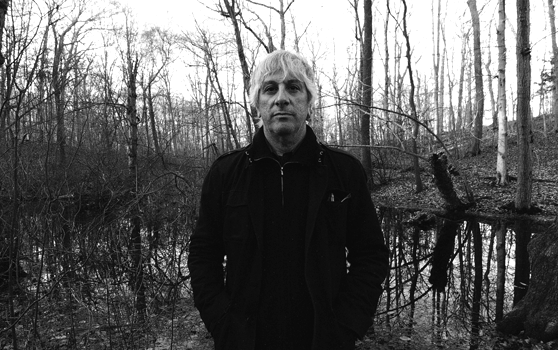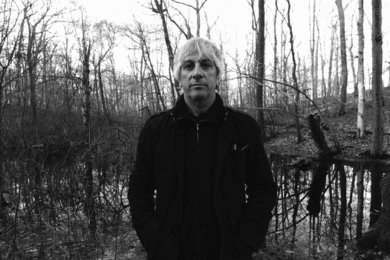It seems that for Lee Ranaldo, music is a constellation of ideas. He’s one of those rare musicians who has genuinely pushed musical boundaries, having taken the art of noise into mainstream rock with Sonic Youth. And yet on his new solo record, Between The Times & The Tides, Ranaldo has left behind a 30-year-plus association with dissonance – the dark element in a world of tonic harmonies – for a set of catchy, poppy tunes that establish a new aspect in his career, a new musical character.
If Sonic Youth are tonally expansive, they’re also sometimes difficult, immersively noisy, almost nausea-inducing; music to be experienced, perhaps, but not always pleasant. The same goes for Ranaldo’s solo work to date, which often lacked the song structures with which Sonic Youth bridged the gap between abstraction and the mainstream. It’s focused on the sonic event and its conceptual underpinnings; Randaldo’s methods range from growing mushrooms on blank score paper to create graphic scores (in tribute to John Cage) to sending distorted guitars into frenzied walls of sound.
All in all, it’s been an more extreme take on the Sonic Youth sound, resembling and sometimes outdoing their SYR series of experimental albums. So do the simple melodies and nicely phrased lyrics of Between The Times & The Tides indicate a new craving to write ‘proper’ songs?
This is your first solo album with a song-led approach. Had you been thinking about making this kind of record for a while?
Lee Ranaldo: I’d been thinking about it for a while, it’s something I’ve wanted to do. I’ve always liked writing on acoustic guitars, even back during those early Sonic Youth days. I have plenty of old tapes of me playing an acoustic guitar when I was trying out songs. So yeah, it’d been something I’d want to do, to make a kind of simple, acoustic album. And I did think about doing that – just with an acoustic guitar and a microphone, like that.
I’ve already got material together to do something similar. I’m really enjoying myself, I think this is something I’d like to keep doing for a long time. I’ll do it for as long as it stays interesting.
The album started out with just you on an acoustic guitar, but you’ve got some high-profile contributors. How important were they in shaping the sound of the LP?
LR: Oh, well people like Nels Cline. Nels and I have been friends for a long-time. I had an idea for how I wanted the songs, but everybody really did bring what they wanted to the record. I knew I wanted some keyboards on the record, so we’ve got John Medeski on there, and with Bob Bert … He lives in the area and he said ‘Hey I’ve been learning the bongos’, and so I just said ‘Let’s see if we can get some bongos on there’. It was a real family atmosphere. With O’Rourke, he did bass work from Japan – I sent the files over.
You’ve done a lot of ‘noise’ work in the past. Did you suppress that deliberately here?
LR: I wouldn’t say deliberately. With other acoustic stuff, older demos and stuff, I guess I’d often kind of ‘Sonic’ them up – especially if they might be used for something with Sonic Youth – and of course that wasn’t something that would happen this time.
But the thing did sort of just evolve. I demoed them on my iPhone with an acoustic, I re-recorded them as demos. Steve [Shelley – Sonic Youth drummer] was the first person to add something to them, so then they were demos of acoustic and drums. Then they became guitar-and-bass-and-drums demos.
Who were your influences? How conscious were you of Sonic Youth when you did choose to write a song-led album?
LR: Sonic Youth weren’t really an influence, and they weren’t really not an influence, because Sonic Youth is in my body, so it’d never be that way – I couldn’t think of it like
that. But really it couldn’t sound like Sonic Youth because Sonic Youth really has to be all of us together. It really is collaborative. With this record, I had sat down to write things and I gave a kind of idea about how I wanted things to sound. I was conscious that I wanted to make an album. Today, albums don’t really mean what they did – we’re kind of back to the days of hot singles – and I wanted this to work as an album.
In terms of influence, I really looked back to what is, I guess, a kind of older generation of songwriting. Joni Mitchell, Neil Young, Leonard Cohen, that kind of thing. But I maybe had in mind stuff like Cat Power, too.
You’ll be touring with Steve Shelley, among others. Will it be strange touring with him after the Sonic Youth split?
LR: It’ll be kind of weird, because other than with Sonic Youth I’ve never done a tour of this size. Often with my other work it’s been one-off shows. And on those big tours you’ve got so many people – all the technicians, stage managers, and somebody to tune all the guitars for you, which was obviously really important when it’s Sonic Youth. With this it’s kind of like going back to the old days, of carrying your own equipment and all that. We’ve already done some shows, and it’s been fun.
Have Sonic Youth met up since the hiatus? Are there plans to?
LR: Yeah – we’ve not met up as a four, for obvious reasons, as you could guess, but I’m talking to everybody, and we’ve met up here and there. These are people who have been part of my life for 30 years; I can’t think of a time when they wouldn’t be. I can’t see how they won’t be for – well, forever.



